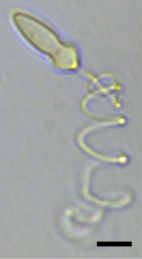

I blog for a number of reasons, but one is a form of professional development. In addition to organizing my research, I will park videos here that I plan to use in my classes using the stories I tell my students label. Since I'll be teaching my evolution, ecology, and biodiversity class starting next month as well as new sections of my environmental science class, it's time for me to stock up. Here are three videos that popped up on my YouTube subscriptions over the past few days.
The first is from AAAS/Science Magazine: Hunting microbe wields a “gatling gun” harpoon.
Single-celled organisms have intricate microscopic weapons evolved for capturing prey.As soon as I saw the preview image, I knew this was about dinoflagellates. At least now I have something interesting to tell my students about them other than red tides and bioluminescence.
Follow over the jump for two videos about mammals that work equally well for my advanced students as for my general onces.
I've written irregularly about de-extinction. The animal mentioned most often is the Woolly Mammoth. Another is the Tasmanian Tiger or Tasmanian Wolf. If rumors are correct, that might not be necessary, as Newsy reports Sightings of extinct Tasmanian tiger rumored.
Australia's Tasmanian tiger was declared "extinct by international standards" in 1986, but the alleged sightings keep popping up.I have strong doubts the animal is still extant, especially in Queensland. The accepted interpretation of the available evidence is that it went extinct on the mainland 3,000 years ago because of competition from dingos. That written, it is possible, if not probable, that it's still there. It's also possible this might be someone's idea of an April Fools hoax. Here's to finding out, one way or another.
Finally, Newsy has more wildlife conservation news in China plans massive panda preserve.
China announced a 10,000-square-mile panda preserve to help conserve the panda population.Now, this is real good news, something I can use to cheer up myself and my students when I've shown them enough DOOM.
To the untrained eye, "dinoflagellate" suggests a T-rex who's into S&M (although the ultimate example of S&M would be flogging somebody with jellyfish tentacles). As it is, I'm glad biological harpoons haven't evolved in any organisms large enough to target us.
ReplyDeleteIt wouldn't surprise me if a few thylacines have survived. 1936 isn't all that long ago, and Australia's a big and underpopulated place. Their population may well be below a critical size for maintaining genetic diversity, though.
"I'm glad biological harpoons haven't evolved in any organisms large enough to target us."
DeleteIn a way, they have. Jellyfish have very much the same kind of harpoons that these dinoflagellates have, but bigger -- big enough to penetrate human skin. In the case of box jellyfish, the results are very painful and can be deadly.